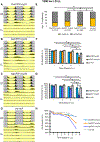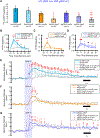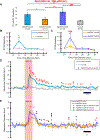Mosquito cryptochromes expressed in Drosophila confer species-specific behavioral light responses
- PMID: 35914532
- PMCID: PMC9810238
- DOI: 10.1016/j.cub.2022.07.021
Mosquito cryptochromes expressed in Drosophila confer species-specific behavioral light responses
Abstract
Cryptochrome (CRY) is a short-wavelength light-sensitive photoreceptor expressed in a subset of circadian neurons and eyes in Drosophila that regulates light-evoked circadian clock resetting. Acutely, light evokes rapid electrical excitation of the ventral lateral subset of circadian neurons and confers circadian-modulated avoidance behavioral responses to short-wavelength light. Recent work shows dramatically different avoidance versus attraction behavioral responses to short-wavelength light in day-active versus night-active mosquitoes and that these behavioral responses are attenuated by CRY protein degradation by constant light exposure in mosquitoes. To determine whether CRY1s mediate species-specific coding for behavioral and electrophysiological light responses, we used an "empty neuron" approach and transgenically expressed diurnal Aedes aegypti (AeCRY1) versus nocturnal Anopheles gambiae (AgCRY1) in a cry-null Drosophila background. AeCRY1 is much less light sensitive than either AgCRY1 or DmCRY as shown by partial behavioral rhythmicity following constant light exposure. Remarkably, expression of nocturnal AgCRY1 confers low survival to constant white light as does expression of AeCRY1 to a lesser extent. AgCRY1 mediates significantly stronger electrophysiological cell-autonomous responses to 365 nm ultraviolet (UV) light relative to AeCRY1. AgCRY1 expression mediates electrophysiological sensitivity to 635 nm red light, whereas AeCRY1 does not, consistent with species-specific mosquito red light responses. AgCRY1 and DmCRY mediate intensity-dependent avoidance behavior to UV light at different light intensity thresholds, whereas AeCRY1 does not, thus mimicking mosquito and fly behaviors. These findings highlight CRY as a key non-image-forming visual photoreceptor that mediates physiological and behavioral light responses in a species-specific fashion.
Keywords: Aedes aegypti; Anopheles gambiae; Cryptochrome; Drosophila melanogaster; circadian neurons; electrophysiology; light-evoked behavior; mosquito sensory biology; non-image forming vision; phototransduction.
Copyright © 2022 The Authors. Published by Elsevier Inc. All rights reserved.
Conflict of interest statement
Declaration of interests The authors declare no competing interests.
Figures







Similar articles
-
Nocturnal mosquito Cryptochrome 1 mediates greater electrophysiological and behavioral responses to blue light relative to diurnal mosquito Cryptochrome 1.Front Neurosci. 2022 Nov 30;16:1042508. doi: 10.3389/fnins.2022.1042508. eCollection 2022. Front Neurosci. 2022. PMID: 36532283 Free PMC article.
-
CRYPTOCHROME mediates behavioral executive choice in response to UV light.Proc Natl Acad Sci U S A. 2017 Jan 24;114(4):776-781. doi: 10.1073/pnas.1607989114. Epub 2017 Jan 6. Proc Natl Acad Sci U S A. 2017. PMID: 28062690 Free PMC article.
-
Distinct mechanisms of Drosophila CRYPTOCHROME-mediated light-evoked membrane depolarization and in vivo clock resetting.Proc Natl Acad Sci U S A. 2019 Nov 12;116(46):23339-23344. doi: 10.1073/pnas.1905023116. Epub 2019 Oct 28. Proc Natl Acad Sci U S A. 2019. PMID: 31659046 Free PMC article.
-
Drosophila Cryptochrome: Variations in Blue.J Biol Rhythms. 2020 Feb;35(1):16-27. doi: 10.1177/0748730419878290. Epub 2019 Oct 10. J Biol Rhythms. 2020. PMID: 31599203 Free PMC article. Review.
-
A fly's eye view of circadian entrainment.J Biol Rhythms. 2003 Jun;18(3):206-16. doi: 10.1177/0748730403018003003. J Biol Rhythms. 2003. PMID: 12828278 Review.
Cited by
-
Rhythms in insect olfactory systems: underlying mechanisms and outstanding questions.J Exp Biol. 2024 Nov 1;227(21):jeb244182. doi: 10.1242/jeb.244182. Epub 2024 Nov 7. J Exp Biol. 2024. PMID: 39508241 Review.
-
Oviposition Response to Light With Different Spectra in the Crepuscular Moth Grapholita molesta.Ecol Evol. 2025 Aug 29;15(9):e72096. doi: 10.1002/ece3.72096. eCollection 2025 Sep. Ecol Evol. 2025. PMID: 40896093 Free PMC article.
-
Loss of functional cryptochrome 1 reduces robustness of 24-hour behavioral rhythms in monarch butterflies.iScience. 2024 Jan 20;27(2):108980. doi: 10.1016/j.isci.2024.108980. eCollection 2024 Feb 16. iScience. 2024. PMID: 38333697 Free PMC article.
-
The cycle gene is essential for both daily responses and seasonal reproduction in the Northern house mosquito, Culex pipiens.Sci Rep. 2025 Aug 2;15(1):28279. doi: 10.1038/s41598-025-06637-y. Sci Rep. 2025. PMID: 40753163 Free PMC article.
-
Nocturnal mosquito Cryptochrome 1 mediates greater electrophysiological and behavioral responses to blue light relative to diurnal mosquito Cryptochrome 1.Front Neurosci. 2022 Nov 30;16:1042508. doi: 10.3389/fnins.2022.1042508. eCollection 2022. Front Neurosci. 2022. PMID: 36532283 Free PMC article.
References
-
- Whitfield J Portrait of a serial killer. Nature (2002) 10.1038/news021001-6 - DOI
-
- Bidlingmayer WL (1994) How Mosquitoes See Traps: Role of Visual Responses. J. Am. Mosq. Control Assoc. 10, 272–279. - PubMed
-
- Ditzen M, Pellegrino M, and Vosshall LB (2008) Insect Odorant Receptors Are Molecular Targets of the Insect Repellent DEET. Science 319, 1838–1842. - PubMed
-
- Lazzari CR (2009) Chapter 1 Orientation Towards Hosts in Haematophagous Insects. In Advances in Insect Physiology; Elsevier; 37, 1–58.
Publication types
MeSH terms
Substances
Grants and funding
LinkOut - more resources
Full Text Sources
Medical
Molecular Biology Databases

